Analysis of Nurse-Patient Communication: A Case Study Presentation
VerifiedAdded on 2022/11/13
|13
|1465
|211
Presentation
AI Summary
This presentation offers a detailed analysis of a healthcare case study, examining the communication processes between a nurse, a patient, and the patient's family members. It identifies instances of both effective and ineffective verbal and non-verbal communication, highlighting the impact of cultural considerations, aggressive tones, and lack of empathy. The presentation explores effective communication strategies, including cultural competence, positive therapeutic approaches, and support through caring conversations. It includes a SOAP note documenting ineffective communication and an SBAR approach for clinical handover, providing a comprehensive overview of the case. The analysis emphasizes the importance of a positive therapeutic environment, culturally safe care, and effective communication to improve patient outcomes and satisfaction. The presentation concludes by reinforcing the significance of healthcare communication and its direct impact on overall patient health and well-being.

Case Study
AnalysisSUBMITTED BY:
AnalysisSUBMITTED BY:
Paraphrase This Document
Need a fresh take? Get an instant paraphrase of this document with our AI Paraphraser
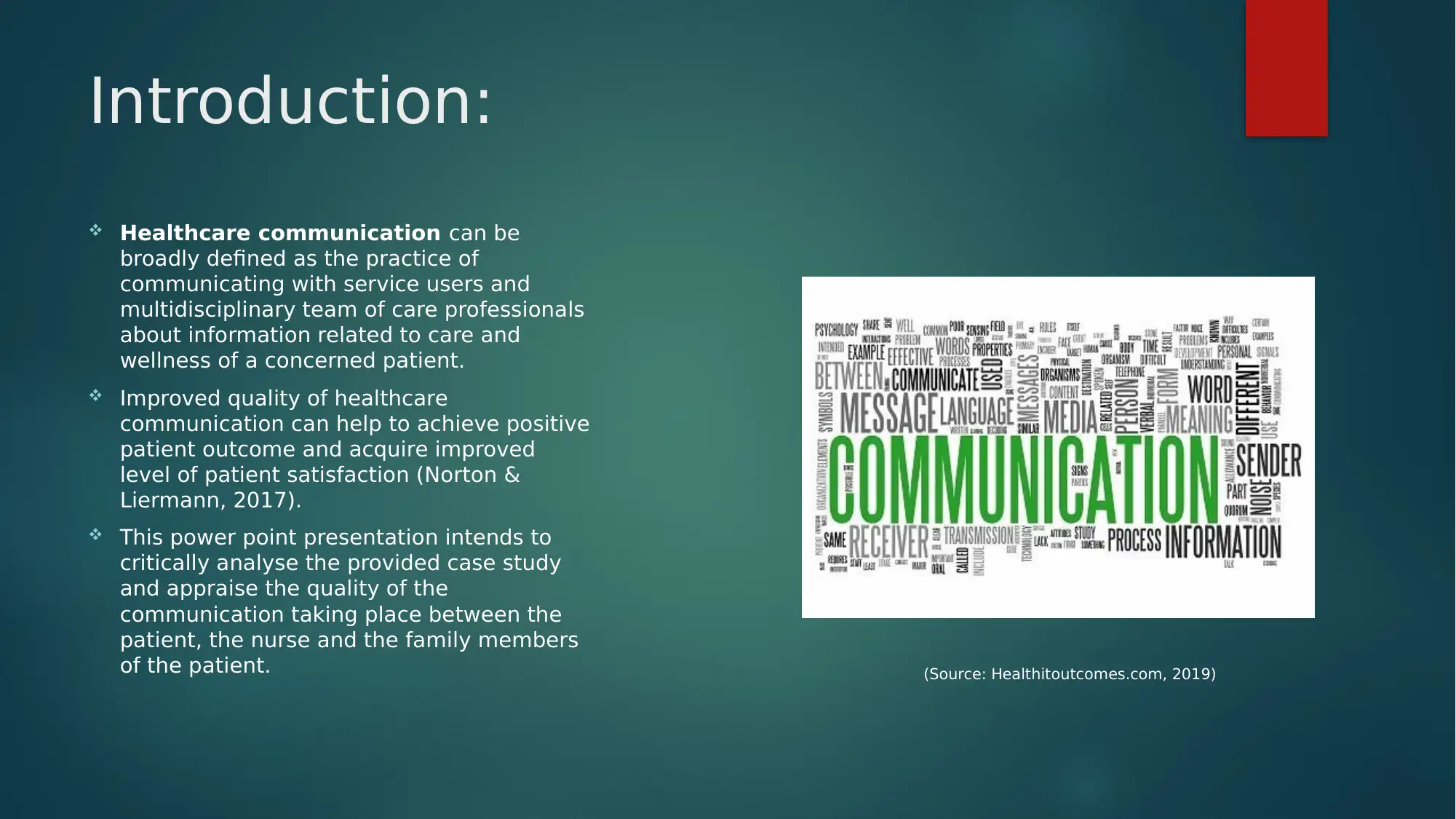
Introduction:
Healthcare communication can be
broadly defined as the practice of
communicating with service users and
multidisciplinary team of care professionals
about information related to care and
wellness of a concerned patient.
Improved quality of healthcare
communication can help to achieve positive
patient outcome and acquire improved
level of patient satisfaction (Norton &
Liermann, 2017).
This power point presentation intends to
critically analyse the provided case study
and appraise the quality of the
communication taking place between the
patient, the nurse and the family members
of the patient. (Source: Healthitoutcomes.com, 2019)
Healthcare communication can be
broadly defined as the practice of
communicating with service users and
multidisciplinary team of care professionals
about information related to care and
wellness of a concerned patient.
Improved quality of healthcare
communication can help to achieve positive
patient outcome and acquire improved
level of patient satisfaction (Norton &
Liermann, 2017).
This power point presentation intends to
critically analyse the provided case study
and appraise the quality of the
communication taking place between the
patient, the nurse and the family members
of the patient. (Source: Healthitoutcomes.com, 2019)
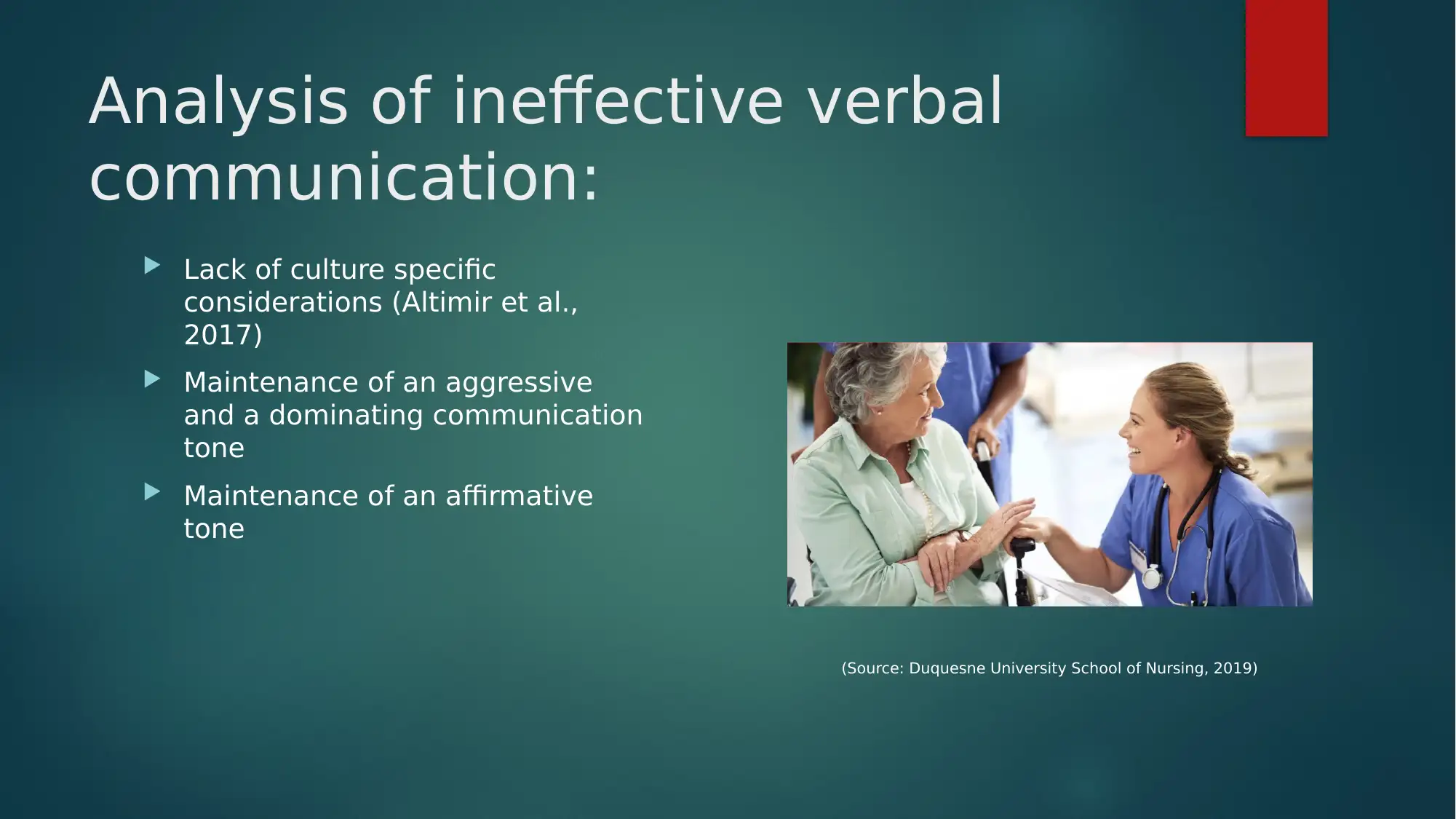
Analysis of ineffective verbal
communication:
Lack of culture specific
considerations (Altimir et al.,
2017)
Maintenance of an aggressive
and a dominating communication
tone
Maintenance of an affirmative
tone
(Source: Duquesne University School of Nursing, 2019)
communication:
Lack of culture specific
considerations (Altimir et al.,
2017)
Maintenance of an aggressive
and a dominating communication
tone
Maintenance of an affirmative
tone
(Source: Duquesne University School of Nursing, 2019)
⊘ This is a preview!⊘
Do you want full access?
Subscribe today to unlock all pages.

Trusted by 1+ million students worldwide
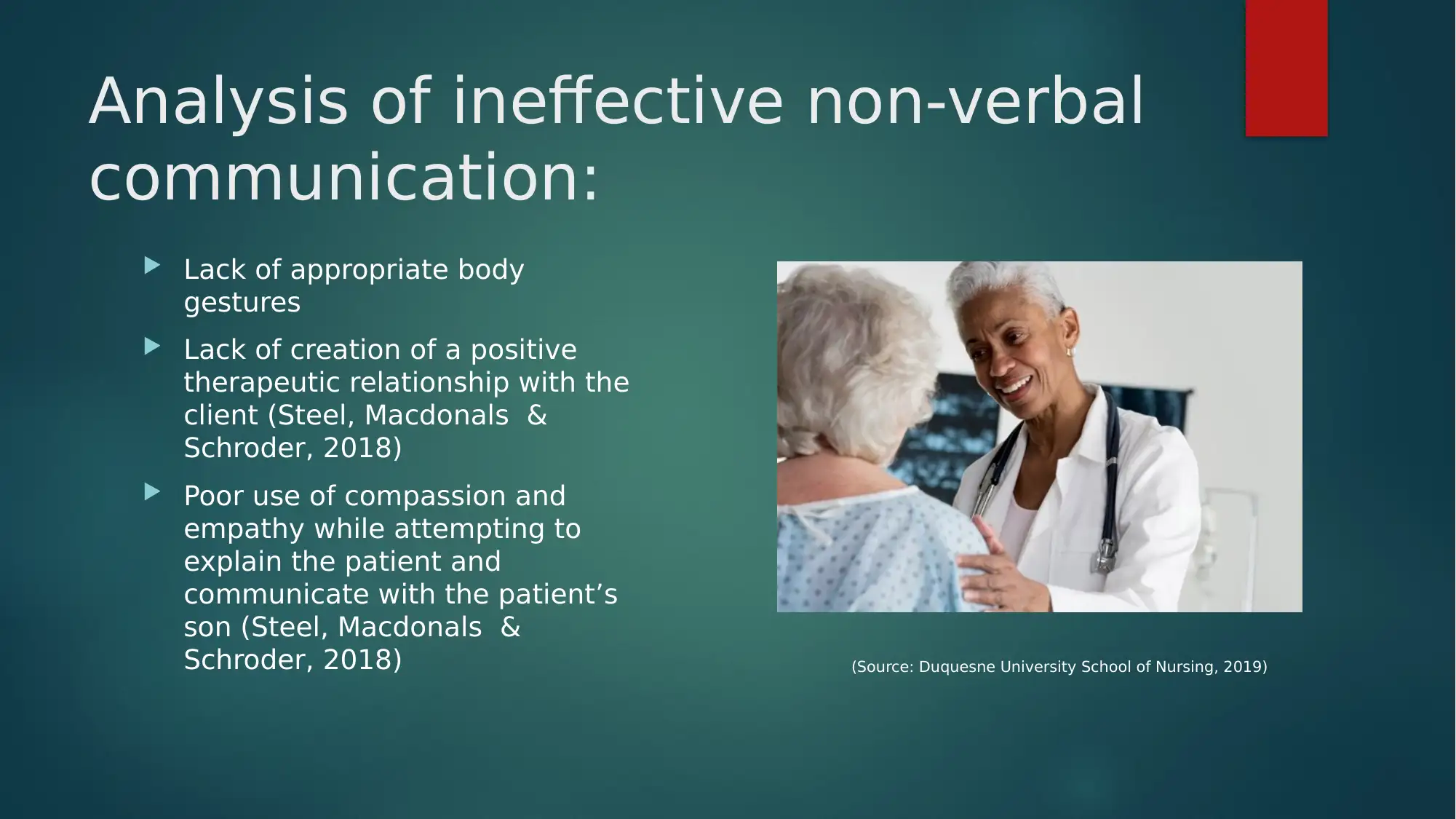
Analysis of ineffective non-verbal
communication:
Lack of appropriate body
gestures
Lack of creation of a positive
therapeutic relationship with the
client (Steel, Macdonals &
Schroder, 2018)
Poor use of compassion and
empathy while attempting to
explain the patient and
communicate with the patient’s
son (Steel, Macdonals &
Schroder, 2018) (Source: Duquesne University School of Nursing, 2019)
communication:
Lack of appropriate body
gestures
Lack of creation of a positive
therapeutic relationship with the
client (Steel, Macdonals &
Schroder, 2018)
Poor use of compassion and
empathy while attempting to
explain the patient and
communicate with the patient’s
son (Steel, Macdonals &
Schroder, 2018) (Source: Duquesne University School of Nursing, 2019)
Paraphrase This Document
Need a fresh take? Get an instant paraphrase of this document with our AI Paraphraser
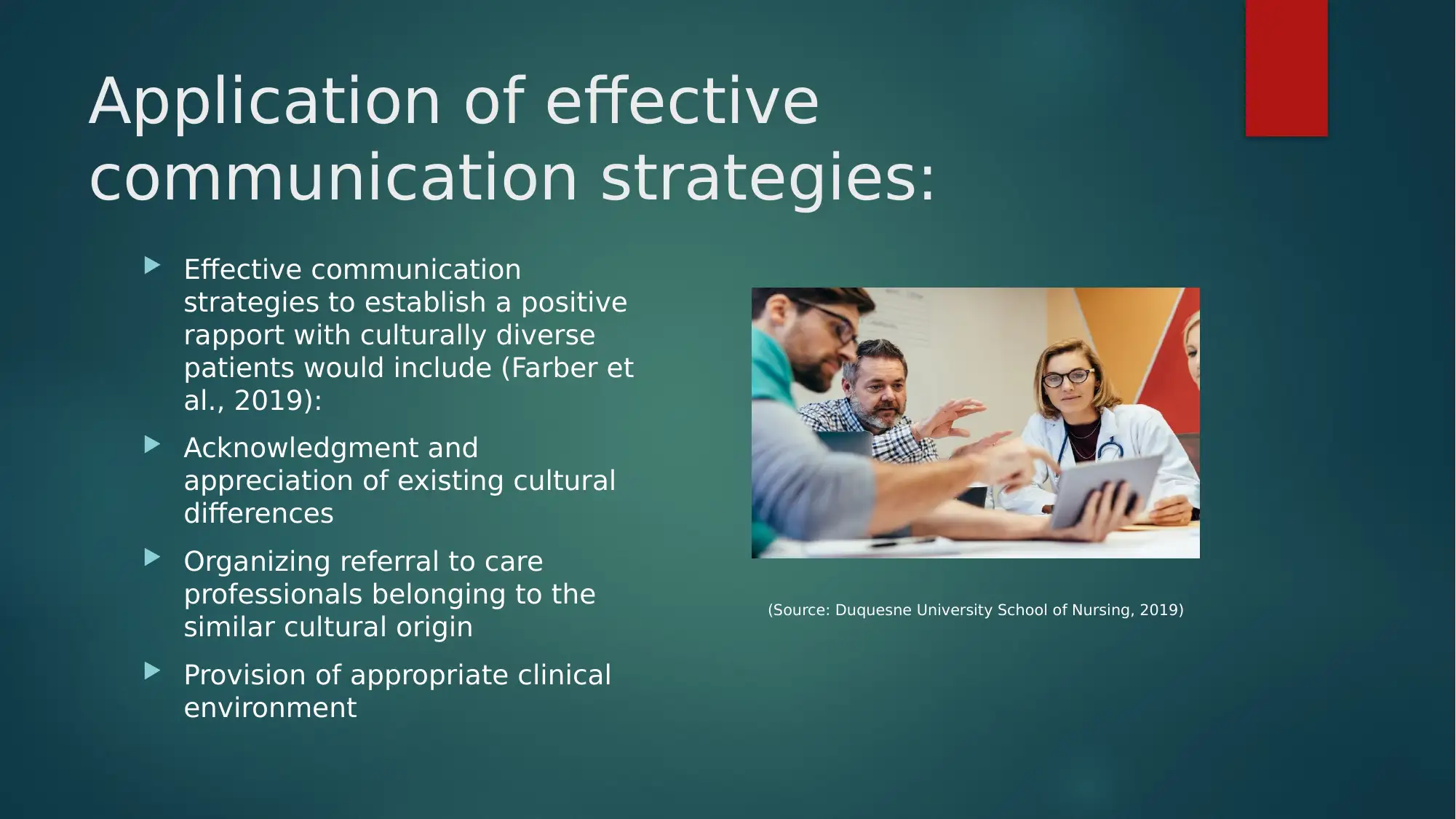
Application of effective
communication strategies:
Effective communication
strategies to establish a positive
rapport with culturally diverse
patients would include (Farber et
al., 2019):
Acknowledgment and
appreciation of existing cultural
differences
Organizing referral to care
professionals belonging to the
similar cultural origin
Provision of appropriate clinical
environment
(Source: Duquesne University School of Nursing, 2019)
communication strategies:
Effective communication
strategies to establish a positive
rapport with culturally diverse
patients would include (Farber et
al., 2019):
Acknowledgment and
appreciation of existing cultural
differences
Organizing referral to care
professionals belonging to the
similar cultural origin
Provision of appropriate clinical
environment
(Source: Duquesne University School of Nursing, 2019)
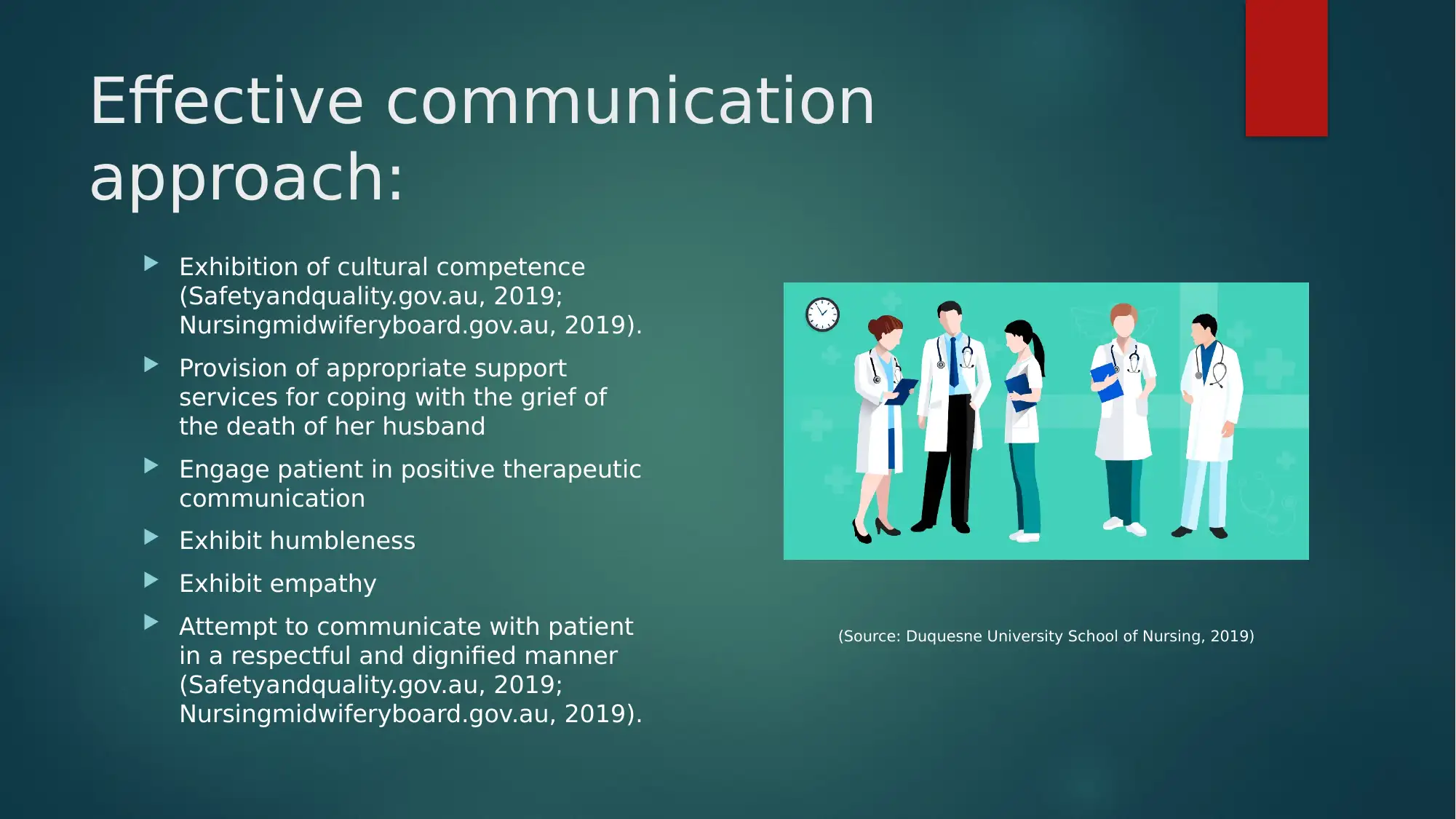
Effective communication
approach:
Exhibition of cultural competence
(Safetyandquality.gov.au, 2019;
Nursingmidwiferyboard.gov.au, 2019).
Provision of appropriate support
services for coping with the grief of
the death of her husband
Engage patient in positive therapeutic
communication
Exhibit humbleness
Exhibit empathy
Attempt to communicate with patient
in a respectful and dignified manner
(Safetyandquality.gov.au, 2019;
Nursingmidwiferyboard.gov.au, 2019).
(Source: Duquesne University School of Nursing, 2019)
approach:
Exhibition of cultural competence
(Safetyandquality.gov.au, 2019;
Nursingmidwiferyboard.gov.au, 2019).
Provision of appropriate support
services for coping with the grief of
the death of her husband
Engage patient in positive therapeutic
communication
Exhibit humbleness
Exhibit empathy
Attempt to communicate with patient
in a respectful and dignified manner
(Safetyandquality.gov.au, 2019;
Nursingmidwiferyboard.gov.au, 2019).
(Source: Duquesne University School of Nursing, 2019)
⊘ This is a preview!⊘
Do you want full access?
Subscribe today to unlock all pages.

Trusted by 1+ million students worldwide
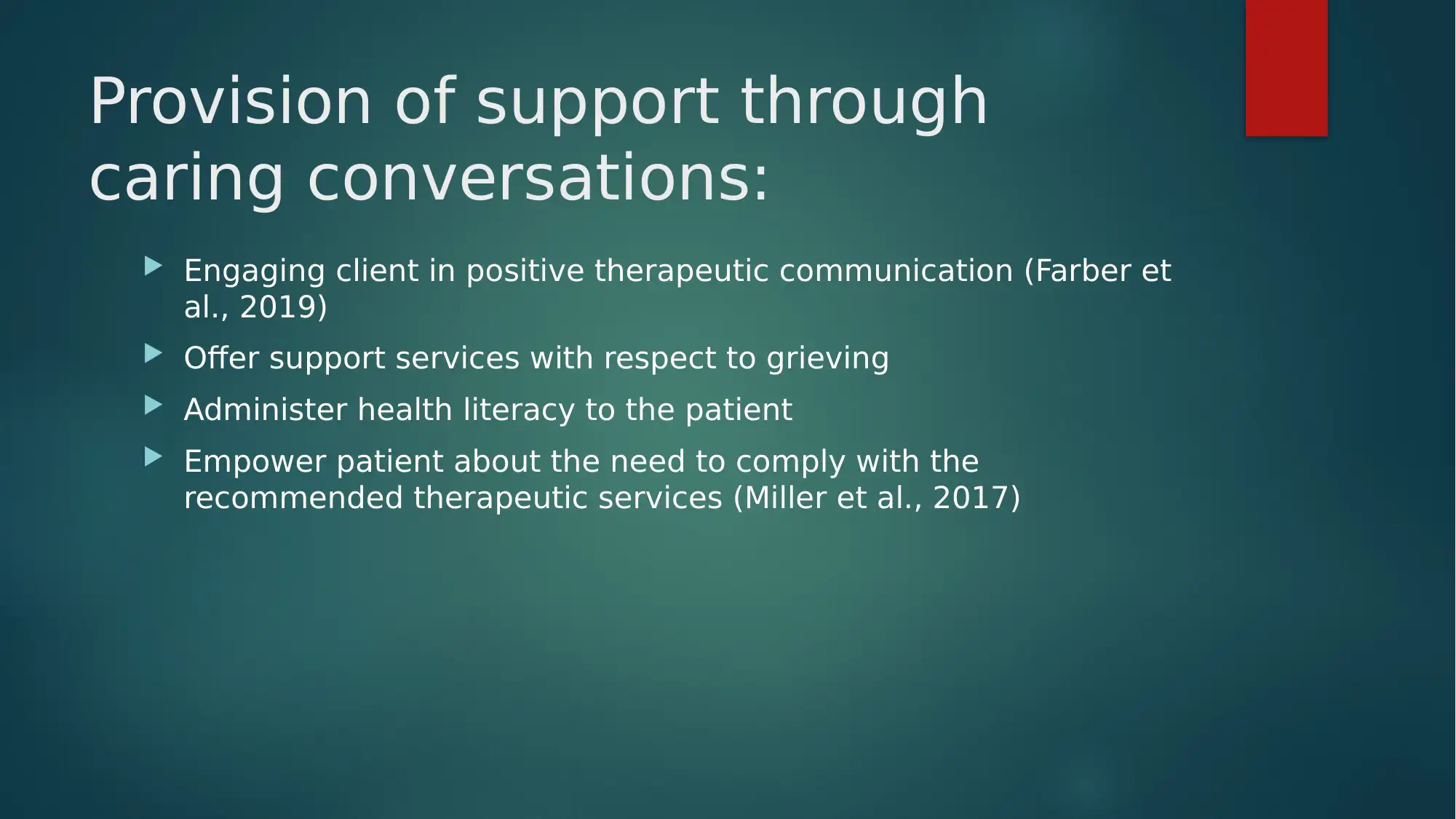
Provision of support through
caring conversations:
Engaging client in positive therapeutic communication (Farber et
al., 2019)
Offer support services with respect to grieving
Administer health literacy to the patient
Empower patient about the need to comply with the
recommended therapeutic services (Miller et al., 2017)
caring conversations:
Engaging client in positive therapeutic communication (Farber et
al., 2019)
Offer support services with respect to grieving
Administer health literacy to the patient
Empower patient about the need to comply with the
recommended therapeutic services (Miller et al., 2017)
Paraphrase This Document
Need a fresh take? Get an instant paraphrase of this document with our AI Paraphraser
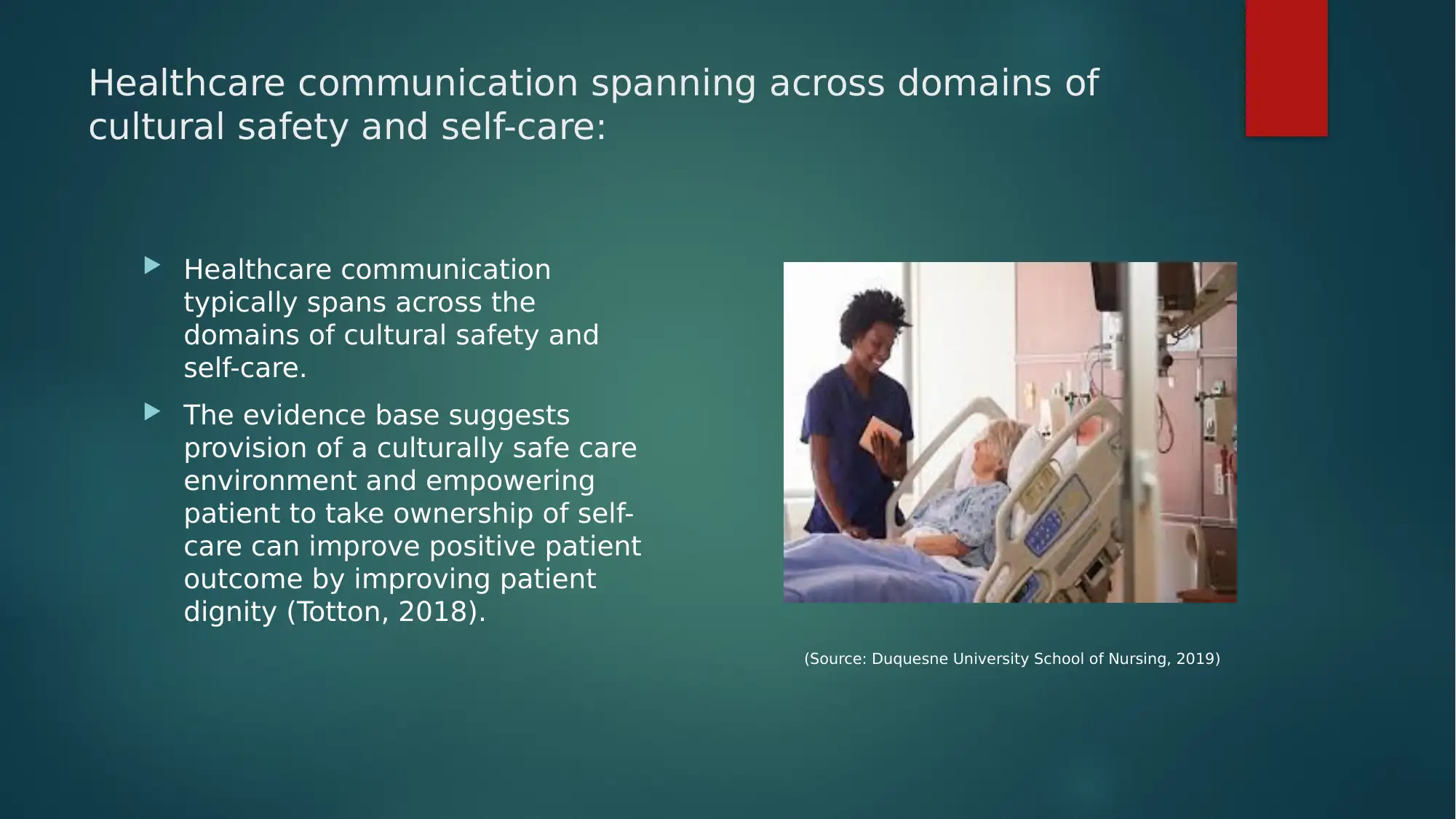
Healthcare communication spanning across domains of
cultural safety and self-care:
Healthcare communication
typically spans across the
domains of cultural safety and
self-care.
The evidence base suggests
provision of a culturally safe care
environment and empowering
patient to take ownership of self-
care can improve positive patient
outcome by improving patient
dignity (Totton, 2018).
(Source: Duquesne University School of Nursing, 2019)
cultural safety and self-care:
Healthcare communication
typically spans across the
domains of cultural safety and
self-care.
The evidence base suggests
provision of a culturally safe care
environment and empowering
patient to take ownership of self-
care can improve positive patient
outcome by improving patient
dignity (Totton, 2018).
(Source: Duquesne University School of Nursing, 2019)
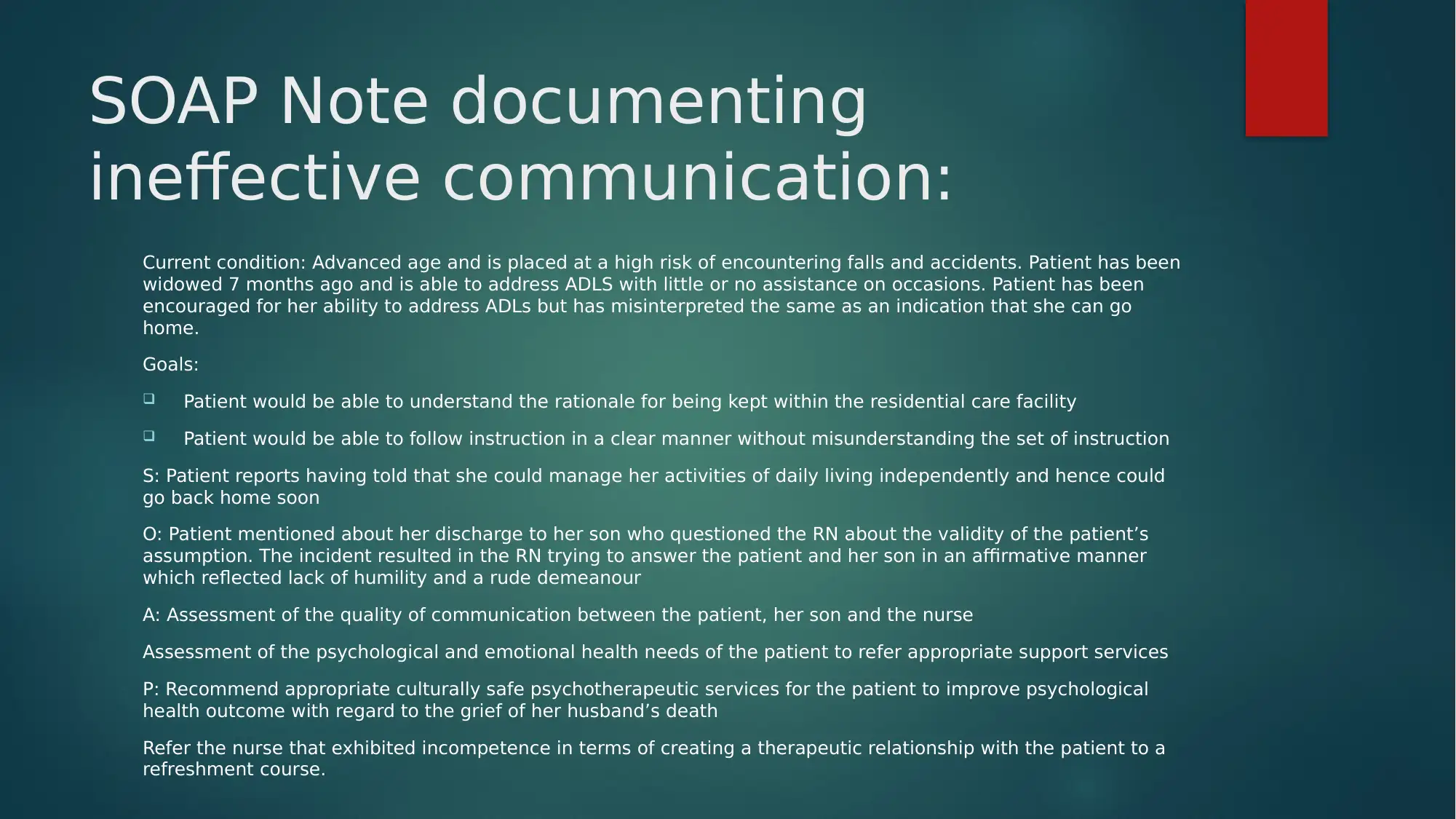
SOAP Note documenting
ineffective communication:
Current condition: Advanced age and is placed at a high risk of encountering falls and accidents. Patient has been
widowed 7 months ago and is able to address ADLS with little or no assistance on occasions. Patient has been
encouraged for her ability to address ADLs but has misinterpreted the same as an indication that she can go
home.
Goals:
Patient would be able to understand the rationale for being kept within the residential care facility
Patient would be able to follow instruction in a clear manner without misunderstanding the set of instruction
S: Patient reports having told that she could manage her activities of daily living independently and hence could
go back home soon
O: Patient mentioned about her discharge to her son who questioned the RN about the validity of the patient’s
assumption. The incident resulted in the RN trying to answer the patient and her son in an affirmative manner
which reflected lack of humility and a rude demeanour
A: Assessment of the quality of communication between the patient, her son and the nurse
Assessment of the psychological and emotional health needs of the patient to refer appropriate support services
P: Recommend appropriate culturally safe psychotherapeutic services for the patient to improve psychological
health outcome with regard to the grief of her husband’s death
Refer the nurse that exhibited incompetence in terms of creating a therapeutic relationship with the patient to a
refreshment course.
ineffective communication:
Current condition: Advanced age and is placed at a high risk of encountering falls and accidents. Patient has been
widowed 7 months ago and is able to address ADLS with little or no assistance on occasions. Patient has been
encouraged for her ability to address ADLs but has misinterpreted the same as an indication that she can go
home.
Goals:
Patient would be able to understand the rationale for being kept within the residential care facility
Patient would be able to follow instruction in a clear manner without misunderstanding the set of instruction
S: Patient reports having told that she could manage her activities of daily living independently and hence could
go back home soon
O: Patient mentioned about her discharge to her son who questioned the RN about the validity of the patient’s
assumption. The incident resulted in the RN trying to answer the patient and her son in an affirmative manner
which reflected lack of humility and a rude demeanour
A: Assessment of the quality of communication between the patient, her son and the nurse
Assessment of the psychological and emotional health needs of the patient to refer appropriate support services
P: Recommend appropriate culturally safe psychotherapeutic services for the patient to improve psychological
health outcome with regard to the grief of her husband’s death
Refer the nurse that exhibited incompetence in terms of creating a therapeutic relationship with the patient to a
refreshment course.
⊘ This is a preview!⊘
Do you want full access?
Subscribe today to unlock all pages.

Trusted by 1+ million students worldwide
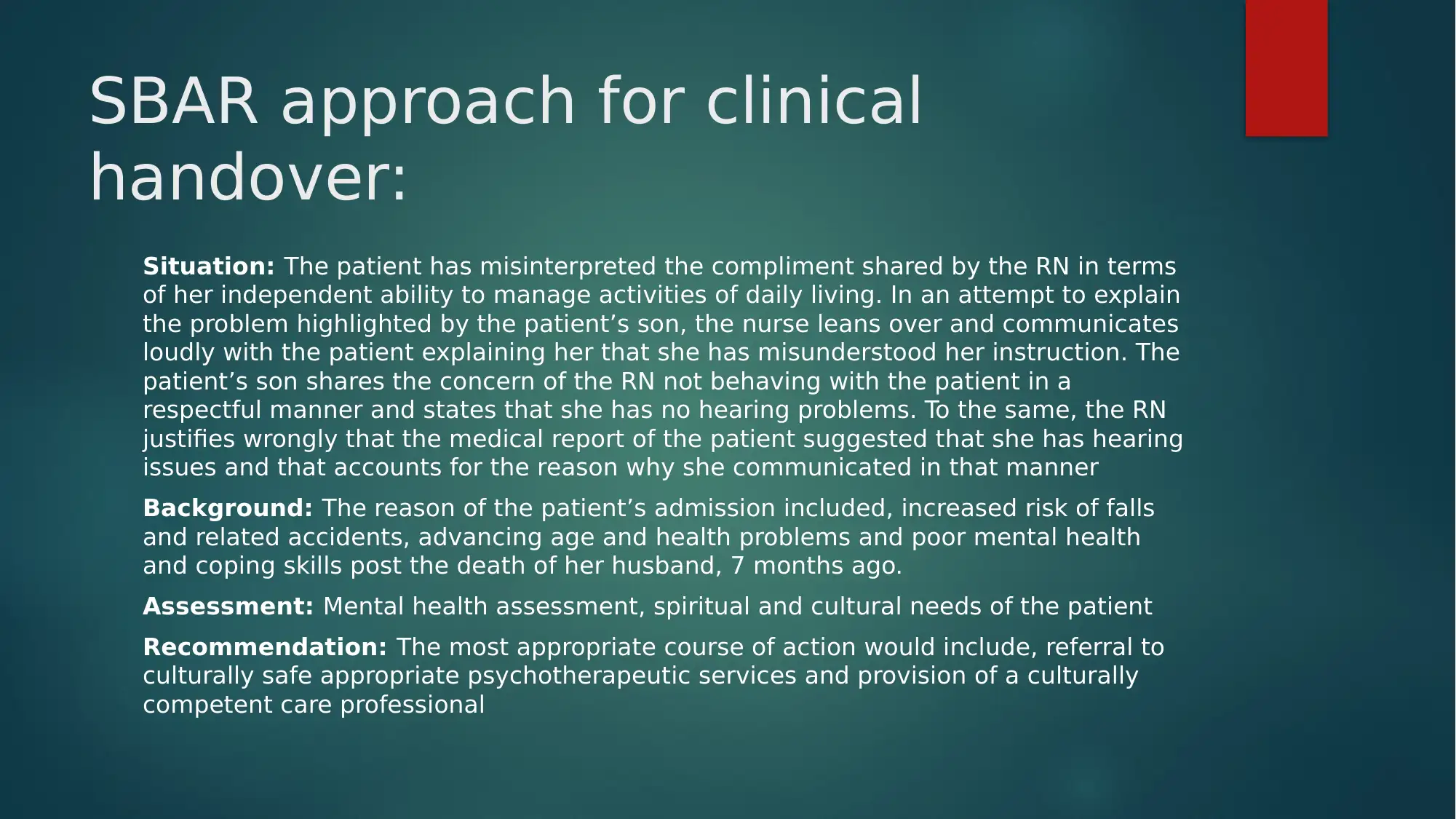
SBAR approach for clinical
handover:
Situation: The patient has misinterpreted the compliment shared by the RN in terms
of her independent ability to manage activities of daily living. In an attempt to explain
the problem highlighted by the patient’s son, the nurse leans over and communicates
loudly with the patient explaining her that she has misunderstood her instruction. The
patient’s son shares the concern of the RN not behaving with the patient in a
respectful manner and states that she has no hearing problems. To the same, the RN
justifies wrongly that the medical report of the patient suggested that she has hearing
issues and that accounts for the reason why she communicated in that manner
Background: The reason of the patient’s admission included, increased risk of falls
and related accidents, advancing age and health problems and poor mental health
and coping skills post the death of her husband, 7 months ago.
Assessment: Mental health assessment, spiritual and cultural needs of the patient
Recommendation: The most appropriate course of action would include, referral to
culturally safe appropriate psychotherapeutic services and provision of a culturally
competent care professional
handover:
Situation: The patient has misinterpreted the compliment shared by the RN in terms
of her independent ability to manage activities of daily living. In an attempt to explain
the problem highlighted by the patient’s son, the nurse leans over and communicates
loudly with the patient explaining her that she has misunderstood her instruction. The
patient’s son shares the concern of the RN not behaving with the patient in a
respectful manner and states that she has no hearing problems. To the same, the RN
justifies wrongly that the medical report of the patient suggested that she has hearing
issues and that accounts for the reason why she communicated in that manner
Background: The reason of the patient’s admission included, increased risk of falls
and related accidents, advancing age and health problems and poor mental health
and coping skills post the death of her husband, 7 months ago.
Assessment: Mental health assessment, spiritual and cultural needs of the patient
Recommendation: The most appropriate course of action would include, referral to
culturally safe appropriate psychotherapeutic services and provision of a culturally
competent care professional
Paraphrase This Document
Need a fresh take? Get an instant paraphrase of this document with our AI Paraphraser
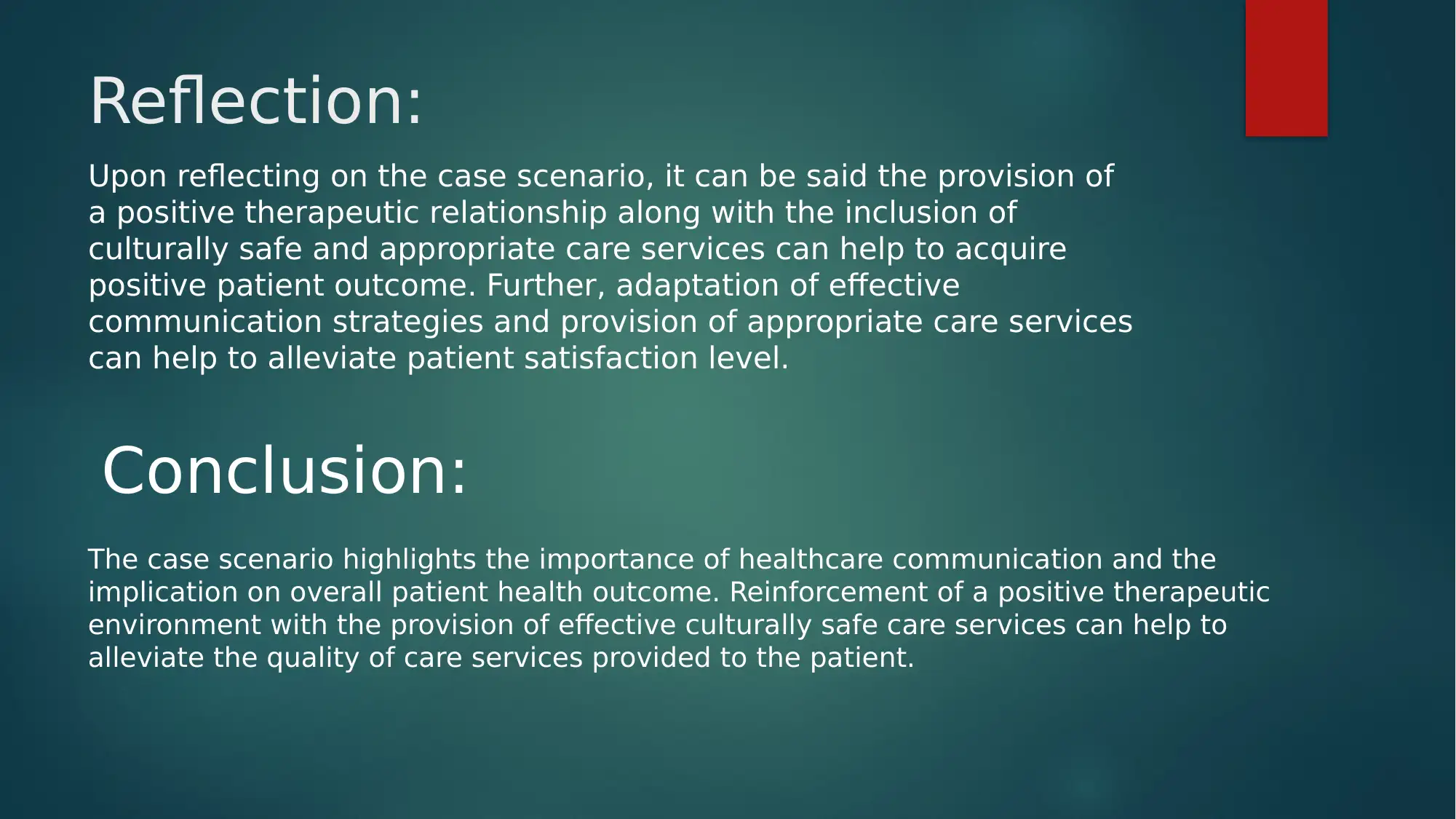
Reflection:
Upon reflecting on the case scenario, it can be said the provision of
a positive therapeutic relationship along with the inclusion of
culturally safe and appropriate care services can help to acquire
positive patient outcome. Further, adaptation of effective
communication strategies and provision of appropriate care services
can help to alleviate patient satisfaction level.
Conclusion:
The case scenario highlights the importance of healthcare communication and the
implication on overall patient health outcome. Reinforcement of a positive therapeutic
environment with the provision of effective culturally safe care services can help to
alleviate the quality of care services provided to the patient.
Upon reflecting on the case scenario, it can be said the provision of
a positive therapeutic relationship along with the inclusion of
culturally safe and appropriate care services can help to acquire
positive patient outcome. Further, adaptation of effective
communication strategies and provision of appropriate care services
can help to alleviate patient satisfaction level.
Conclusion:
The case scenario highlights the importance of healthcare communication and the
implication on overall patient health outcome. Reinforcement of a positive therapeutic
environment with the provision of effective culturally safe care services can help to
alleviate the quality of care services provided to the patient.

References:
Altimir, C., Capella, C., Núñez, L., Abarzúa, M., & Krause, M. (2017). Meeting in difference: Revisiting the therapeutic relationship based on
patients′ and therapists′ experiences in several clinical contexts. Journal of clinical psychology, 73(11), 1510-1522.
Duquesne University School of Nursing (2019). A Nurse’s Role In Patient Education and Patient Satisfaction. [online] Duquesne University
School of Nursing. Available at: https://onlinenursing.duq.edu/blog/nurses-role-patient-education-patient-satisfaction/ [Accessed 17 Sep.
2019].
Farber, B. A., Suzuki, J. Y., & Lynch, D. A. (2019). Positive regard and affirmation. Psychotherapy Relationships that Work: Volume 1:
Evidence-Based Therapist Contributions, 288.
Healthitoutcomes.com (2019). Reduce Barriers To Healthcare With 21st Century Communication Tools. [online] Healthitoutcomes.com.
Available at: https://www.healthitoutcomes.com/doc/reduce-barriers-to-healthcare-with-st-century-communication-tools-0001 [Accessed
17 Sep. 2019].
Miller, R., Hilsenroth, M. J., & Hewitt, P. L. (2017). Perfectionism and therapeutic alliance: a review of the clinical research. Research in
Psychotherapy: Psychopathology, Process and Outcome.
Norton, C., & Liermann, K. (2017). Communication as a Positive Relationship Outcome with Families Participating in a Therapeutic
Wilderness Program. In Family Therapy with Adolescents in Residential Treatment (pp. 407-424). Springer, Cham.
Nursingmidwiferyboard.gov.au (2019). Nursing and Midwifery Board of Australia - Professional standards. [online]
Nursingmidwiferyboard.gov.au. Available at: https://www.nursingmidwiferyboard.gov.au/Codes-Guidelines-Statements/Professional-
standards.aspx [Accessed 17 Sep. 2019].
Safetyandquality.gov.au (2019). The NSQHS Standards | Australian Commission on Safety and Quality in Health Care. [online]
Safetyandquality.gov.au. Available at: https://www.safetyandquality.gov.au/standards/nsqhs-standards [Accessed 17 Sep. 2019].
Steel, C., Macdonald, J., & Schroder, T. (2018). A systematic review of the effect of therapists’ internalized models of relationships on the
quality of the therapeutic relationship. Journal of clinical psychology, 74(1), 5-42.
Totton, N. (2018). Power in the therapeutic relationship. In The Political Self (pp. 29-42). Routledge.
Altimir, C., Capella, C., Núñez, L., Abarzúa, M., & Krause, M. (2017). Meeting in difference: Revisiting the therapeutic relationship based on
patients′ and therapists′ experiences in several clinical contexts. Journal of clinical psychology, 73(11), 1510-1522.
Duquesne University School of Nursing (2019). A Nurse’s Role In Patient Education and Patient Satisfaction. [online] Duquesne University
School of Nursing. Available at: https://onlinenursing.duq.edu/blog/nurses-role-patient-education-patient-satisfaction/ [Accessed 17 Sep.
2019].
Farber, B. A., Suzuki, J. Y., & Lynch, D. A. (2019). Positive regard and affirmation. Psychotherapy Relationships that Work: Volume 1:
Evidence-Based Therapist Contributions, 288.
Healthitoutcomes.com (2019). Reduce Barriers To Healthcare With 21st Century Communication Tools. [online] Healthitoutcomes.com.
Available at: https://www.healthitoutcomes.com/doc/reduce-barriers-to-healthcare-with-st-century-communication-tools-0001 [Accessed
17 Sep. 2019].
Miller, R., Hilsenroth, M. J., & Hewitt, P. L. (2017). Perfectionism and therapeutic alliance: a review of the clinical research. Research in
Psychotherapy: Psychopathology, Process and Outcome.
Norton, C., & Liermann, K. (2017). Communication as a Positive Relationship Outcome with Families Participating in a Therapeutic
Wilderness Program. In Family Therapy with Adolescents in Residential Treatment (pp. 407-424). Springer, Cham.
Nursingmidwiferyboard.gov.au (2019). Nursing and Midwifery Board of Australia - Professional standards. [online]
Nursingmidwiferyboard.gov.au. Available at: https://www.nursingmidwiferyboard.gov.au/Codes-Guidelines-Statements/Professional-
standards.aspx [Accessed 17 Sep. 2019].
Safetyandquality.gov.au (2019). The NSQHS Standards | Australian Commission on Safety and Quality in Health Care. [online]
Safetyandquality.gov.au. Available at: https://www.safetyandquality.gov.au/standards/nsqhs-standards [Accessed 17 Sep. 2019].
Steel, C., Macdonald, J., & Schroder, T. (2018). A systematic review of the effect of therapists’ internalized models of relationships on the
quality of the therapeutic relationship. Journal of clinical psychology, 74(1), 5-42.
Totton, N. (2018). Power in the therapeutic relationship. In The Political Self (pp. 29-42). Routledge.
⊘ This is a preview!⊘
Do you want full access?
Subscribe today to unlock all pages.

Trusted by 1+ million students worldwide
1 out of 13
Your All-in-One AI-Powered Toolkit for Academic Success.
+13062052269
info@desklib.com
Available 24*7 on WhatsApp / Email
![[object Object]](/_next/static/media/star-bottom.7253800d.svg)
Unlock your academic potential
Copyright © 2020–2025 A2Z Services. All Rights Reserved. Developed and managed by ZUCOL.

